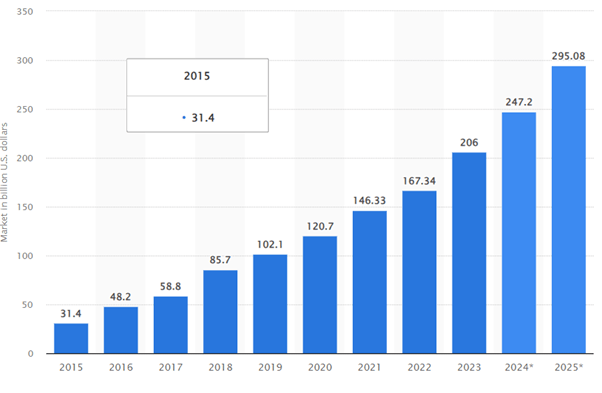Key Takeaways
- The latest trend in the software industry is the cloud native app development.
- Developing cloud native applications can be handled easily by top notch developer experts from Wildnet!
- Read the blog below to know how to beat your competition via a cloud native application!
In this constantly changing digital landscape, a key player has emerged that is projected to be the future of Software Development ,i.e., Cloud Native Application.
With cloud native applications, you get to experience a new level of agility, scalability, and efficiency.
- Do you know what are cloud native applications?
- Why are they being called the future of software development?
In this blog, we will dive into cloud native applications, related queries, their benefits, future trends, and challenges.
If you are a business leader, a developer, or a tech freak, this blog will upgrade your knowledge base about software development.
A few facts about Cloud Native applications
- The global revenue share of Cloud Native applications in 2024 is expected to be USD 247.2 billion

Fig 1. A graphical representation of Global Cloud application revenue share from 2015 to 2025. [Source: Statista]
- 65% of the businesses that opted for cloud native applications chose custom apps.
- 50% of stakeholders chose to manage or build cloud native application platforms.
- 54% of developers use cloud native applications to deploy and test software in the CI/CD or continuous integration/continuous delivery environment.
- In 2024, 72% of the companies are using more than 1 cloud native platforms.
Understanding the Cloud Native Applications
Cloud Native Applications are the latest edition of app development methodology in the software development industry.
They are designed to work in the cloud environment, i.e.,
- Built and run on clouds,
- Using cloud infrastructure and services.
Cloud native apps have smaller and independent services called the microservices.
Earlier, developers used monolithic applications that used to bundle up software as one and made it difficult to work on one of its features.
But using the cloud native approach helps in segmenting the software into multiple services. Each service represents a function and is managed as a microservice.
With microservices architecture, cloud native applications are apt for the agile development framework and utilize minimal computing!
A few cloud native application examples are
- OTT platforms like Netflix
- Lodging & hospitality platforms like Airbnb
- Music streaming apps like Spotify
- Image discovery apps like Pinterest
In short, cloud native applications are
- built using microservices architecture.
- deployed in the containers.
- managed via the Agile DevOps method.
Cloud native applications can thus allow rapid delivery of reliable and complex apps!
Difference between Cloud Native Applications and Traditional Applications
The most important difference between the two is the monolithic design of traditional apps vs. the microservice architecture of cloud native apps.
Monolithic design did not allow the developers to work separately on each function, and thus one minor change would take a lot of time.
This also meant that if one minor change is to be carried out, then the whole application or software will be down.
Microservices architecture, on the other hand, is designed for scalability and agility, as it allows rapid updates in one function while the rest of the app stays online.
Thus, Cloud native applications are designed for the future and fast paced environments.
Cloud Native Applications: Key Characteristics
There are a few key characteristics of the Cloud Native Applications and they are,
Microservices Architecture
With it, you can break down the application into smaller and independent services, each of which represents a function.
It helps in building resilient, flexible, and scalable software.
Containers & Container Orchestration
With containers, you get to bundle up the application and its related contingencies in a portable unit.
Using tools like Kubernetes for container orchestration helps in effectively managing these containers.
These containers help boost security, networking, and scalability.
Dynamic Management via DevOps
Dynamic management is the key to staying on top of market trends and your competitors.
It is possible via DevOps, which brings together the operations and developer teams.
It helps in delivering the CI/CD model and responds to changes rapidly.
Cloud Native Applications: The Benefits
There are many benefits to using the Cloud Native Applications and they are,
Scalability & Resilience
Cloud Native Applications are quite scalable.
With them, you can easily handle the increased user demand or data volume.
Cloud Native Applications are resilient, as they can recover quickly from failures to ensure continuous availability.
Agility & Speed
Cloud Native Applications allow rapid development as you break down complex apps into smaller, independent microservices.
Plus, Cloud Native Applications are quite agile, as they can be upgraded whenever needed in response to changing market trends.
Efficiency & Cost Savings
With its pay-as-you-go model, Cloud Native Applications allow you to save costs.
By aptly using resources and preventing any wastage of time and energy, they are an efficient solution too!
Enhanced UX
UX or user experience, is the leading force behind top notch software development.
With Cloud Native Applications, you can adapt as per the user requirements and preferences to cater a personalized UX!
Cloud Native Applications: Considerations & Challenges
Although the benefits of Cloud Native Applications are overpowering, there are some challenges that one might face with them as well. They are,
Security & Compliance
Since each service is independent and managing a separate database, thus each one of them needs proper security protocols and API connections to prevent any hacking attempts.
Complying with the industry and country-specific standards is also important to stay relevant.
Training & Skill Gaps
Your developer team and operations team would need appropriate training to use the Cloud Native Applications.
They must have the apt skills and experience to allow the best usage of cloud native applications.
The Future of Cloud Native Applications
The future of cloud native applications is to further improve the software development industry.
It is becoming the new normal in app development.
There are several trends that are also creating the hype for the Cloud Native Applications and they are:
App Development Trends
App development needs to be fast, agile, and resilient!
Cloud native applications deliver the same and much more, such as cost savings, reduced time to market, and efficiency.
AI and Machine Learning
AI & ML or machine learning play an essential role in Cloud Native Applications.
As with them, high tech features like automation, predictive analytics, and personalization can be easily imbibed.
With AI and ML, Cloud Native Applications can be much more effective & efficient, optimize the usage of resources, boost performance and improve the UX!
You can also make the switch to a Cloud Native future, but you just have to ensure that you have taken care of the challenges involved!
Conclusion
There is no doubt that the future of software development is in Cloud Native Applications.
Be it embracing new tech, ways of working, or practices, with Cloud Native Applications, you can do it all!
If you wish to stay competitive and be the user favourite, then make the switch to Cloud Native Applications.
Wildnet Technologies is a top notch software development company in India and caters to our clients website, app, and custom software needs.
We integrate the latest tech and trends to ensure that the resultant digital solution helps our clients achieve their business goals & make their users happy via our design & development services and software consulting services.
If you would like to know more,
- UI/UX in Mobile Development in 2024
- AI PCs are here in 2024: What about the AI OS?
- Wildnet’s Digital Yum (our thought leadership’s POV on the week’s latest marketing and IT trends and techs)
Contact us now at info@wildnettechnologies.com and get your Cloud Native Applications built now!
FAQs
FAQ 1. What is the future of cloud-native applications?
Ans: The future of cloud native applications is bright and promising as the market and users demand a fast-paced software development industry.
FAQ 2. Why do we need cloud-native applications?
Ans: To make your apps faster, up-to-date, and available all the time, you need cloud native applications.
Plus, with clod native applications, you can make your apps much more user focused and personalized.
FAQ 3. What are the benefits of using the cloud for software development?
Ans: There are endless benefits of using cloud computing for software development, such as,
- Increased flexibility
- Boosted reliability
- Improved performance
- Heightened efficiency
- Reduced IT infrastructure costs
FAQ 4. Why cloud computing is the future of technology?
Ans: The future of technology isn’t made up of distributed IT infrastructure rather has centralized IT resources.
This means that the user, businesses, and developers can simply login to these clouds and use the services, garner leads, and develop or upgrade software, respectively.
FAQ 5. Will AI replace cloud computing?
Ans: No, as they are meant to go hand in hand.
With cloud computing, all the computing happens at designated places, and the AI can be installed there, too!
This will help in utilizing the IT resources aptly and quicker resolution of any issues, proactively!







